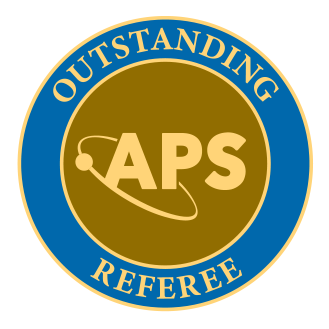| Volume 109, Issue 2 February 2024 | | Advertisement  | In this year, 2024, 156 Outstanding Referees were selected from the 91,600 currently active referees. The honorees come from over 42 different countries and will be recognized at the upcoming March Meeting. Read more. | | | | | |
Advertisement Don't miss these exciting Physical Review Journals events at the 2024 APS March Meeting | | | | Not an APS member? Join today to start connecting with a community of more than 50,000 physicists. | | | | Editors' Suggestion Ivan Lobaskin, Martin R. Evans, and Kirone Mallick Phys. Rev. E 109, 024127 (2024) – Published 23 February 2024  | An exclusion process on a ring is studied in this paper, where the presence of a defect particle immersed in a bath of normal particles leads to phase transitions between localized and shock phases. The authors use the functional Bethe ansatz to analytically compute the mean current and, for the first time, the diffusion constant, and report good agreement with Monte Carlo simulations. | | | | | | Editors' Suggestion Antoine Vendeville, Shi Zhou, and Benjamin Guedj Phys. Rev. E 109, 024312 (2024) – Published 21 February 2024  | The formation and evolution of opinion in social networks is a topic receiving increasing attention. By employing the multistate voter model on a network, the authors derive a general method to compute the probability of disagreement between a pair of agents in the model, which is applicable to any directed, weighted network. | | | | | | Editors' Suggestion Marcelo P. Becker and Marco A. P. Idiart Phys. Rev. E 109, 024406 (2024) – Published 14 February 2024  | This article presents a mean-field method to determine the transfer function that describes the behavior of spiking neurons in a network. The authors extend a Fokker-Planck approach to the case of conductance-based integrate-and-fire neurons with various sources of noise, and find good agreement with data from simulations. | | | | | | Featured in Physics Editors' Suggestion A. Pak et al. Phys. Rev. E 109, 025203 (2024) – Published 5 February 2024  | The target gain greater than unity achieved in a recent fusion experiment was made possible by using additional laser energy at fixed power and controlling sources of degradation. This resulted in increased compression of the fuel and a high fusion yield corresponding to a novel physical regime. This paper describes the experimental evidence for these critical aspects and new observables. | | | | | | Featured in Physics Editors' Suggestion A. L. Kritcher et al. Phys. Rev. E 109, 025204 (2024) – Published 5 February 2024  | In 2022, a National Ignition Facility controlled-fusion experiment reached a target gain G>1, with the fusion energy produced exceeding the amount of laser energy required to drive the target. This result was obtained thanks to careful design described in this paper. This design has been shown to be robust and allows a better understanding of the physical conditions necessary to reach ignition. | | | | | | Editors' Suggestion Letter Aristotelis P. Sgouros, Evangelos Drougkas, Spyros V. Kallivokas, and Doros N. Theodorou Phys. Rev. E 109, L023001 (2024) – Published 8 February 2024  | This work provides a framework for determining the buckling kinetics of membranes under compressive stress. The authors investigate a model of graphene with molecular dynamics simulations and find three regimes: I. Buckling time increases with temperature, II. Buckling time decreases with temperature, and III. Buckling time is independent of temperature. | | | | | | | |


No comments:
Post a Comment